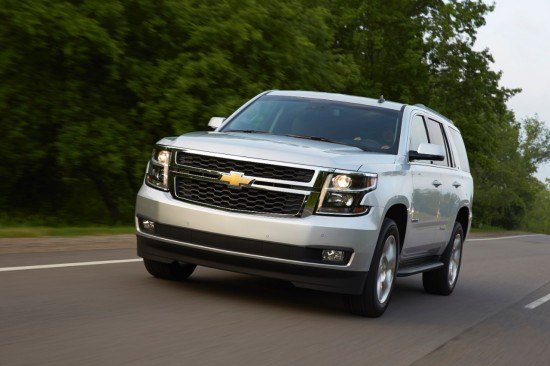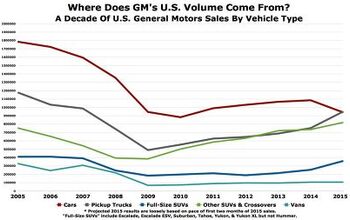GM's July 2014 SUV Strength
U.S. sales of General Motors passenger cars slid 3.8% in July 2014. This 3348-unit loss was created in large part by the Chevrolet Cruze’s 4521-unit decline and the Impala’s 3279-unit slide, decreases which were not completely offset by smaller gains from the Malibu, Sonic, Camaro, Corvette, and Buick’s LaCrosse.
Despite a 5.5% boost in July volume from the GMC Sierra, GM pickup truck sales slid 1.6% as Silverado volume remained level and the company lost 1907 pickup sales from nameplates which are either defunct or have not yet returned.
Yet overall GM sales grew at pace with the market’s fast 9% clip in July. How?
Commercial vans, that’s how.
Yes, really.
But only in part.
Combined sales of the Chevrolet Express and GMC Savana reportedly rose 64.5% to 11,466 units, or 4.5% of GM’s volume. The Express and Savana owned 34.9% of America’s commercial van category in July 2014, up from 29.4% a year ago. (Ford is currently in a transition phase as the E-Series gets set to depart and the Transit slowly takes over.)
In truth, GM’s SUVs and crossovers played the starring role in July. Total sales from GM’s 14 utility vehicle nameplates rose 28% to 100,122 units, or 39.1% of GM’s total July volume, up from 33.4% in July 2013.
The Chevrolet Equinox, GMC Terrain, and fleet-friendly Chevrolet Captiva Sport generated four out of every ten GM SUV/crossover sales. The Lambda-platform trio – Acadia, Enclave, Traverse – brought in another 23%. The truck-based group of six full-size SUVs produced 28% of the SUV/crossover tally, leaving another 9% for the Buick Encore and Cadillac SRX. Among these 14 nameplates, only the SRX (down 7% in July but up 16% year-to-date) and the Chevrolet Suburban (down 16% in July but up 3% YTD) recorded year-over-year declines.
Thanks to its Jeep brand, Chrysler Group/FCA is another big SUV seller. Five Jeeps, plus the Dodge Durango and Journey, generated 71,553 July sales, up 33% from a pre-Cherokee July 2013.
Ford and Lincoln combined for a 17% increase to 64,951 SUV/crossover units.
Toyota, with 11,861 Lexus LX and GX and RX sales included, reported a 61,807-unit utility vehicle July, 25% jump. American Honda sold 49,277 utility vehicles. Nissan and Infiniti, Juke included, reported 36,751 utility vehicle sales.
What of history? In July 2004, General Motors sold 136,263 SUVs from eight different brands. At that time, however, this equalled 30% of GM’s July 2004 volume. Also at that time, GM’s full-size SUVs, including the Hummer H1 and H2, accounted for 43% of the company’s overall utility vehicle sales tally.
In calendar year 2004, the second, third, and tenth-best-selling SUVs in America were GM products, TrailBlazer, Tahoe, and Envoy, respectively. Through the first seven months of 2014, GM has claimed the third (Equinox), 14th (Traverse), 15th (Terrain), and 20th (Tahoe) positions.
More by Timothy Cain
Latest Car Reviews
Read moreLatest Product Reviews
Read moreRecent Comments
- Honda1 Unions were needed back in the early days, not needed know. There are plenty of rules and regulations and government agencies that keep companies in line. It's just a money grad and nothing more. Fain is a punk!
- 1995 SC If the necessary number of employees vote to unionize then yes, they should be unionized. That's how it works.
- Sobhuza Trooper That Dave Thomas fella sounds like the kind of twit who is oh-so-quick to tell us how easy and fun the bus is for any and all of your personal transportation needs. The time to get to and from the bus stop is never a concern. The time waiting for the bus is never a concern. The time waiting for a connection (if there is one) is never a concern. The weather is never a concern. Whatever you might be carrying or intend to purchase is never a concern. Nope, Boo Cars! Yeah Buses! Buses rule!Needless to say, these twits don't actual take the damn bus.
- MaintenanceCosts Nobody here seems to acknowledge that there are multiple use cases for cars.Some people spend all their time driving all over the country and need every mile and minute of time savings. ICE cars are better for them right now.Some people only drive locally and fly when they travel. For them, there's probably a range number that works, and they don't really need more. For the uses for which we use our EV, that would be around 150 miles. The other thing about a low range requirement is it can make 120V charging viable. If you don't drive more than an average of about 40 miles/day, you can probably get enough electrons through a wall outlet. We spent over two years charging our Bolt only through 120V, while our house was getting rebuilt, and never had an issue.Those are extremes. There are all sorts of use cases in between, which probably represent the majority of drivers. For some users, what's needed is more range. But I think for most users, what's needed is better charging. Retrofit apartment garages like Tim's with 240V outlets at every spot. Install more L3 chargers in supermarket parking lots and alongside gas stations. Make chargers that work like Tesla Superchargers as ubiquitous as gas stations, and EV charging will not be an issue for most users.
- MaintenanceCosts I don't have an opinion on whether any one plant unionizing is the right answer, but the employees sure need to have the right to organize. Unions or the credible threat of unionization are the only thing, history has proven, that can keep employers honest. Without it, we've seen over and over, the employers have complete power over the workers and feel free to exploit the workers however they see fit. (And don't tell me "oh, the workers can just leave" - in an oligopolistic industry, working conditions quickly converge, and there's not another employer right around the corner.)

































Comments
Join the conversation
So GM's crossovers are going crazy because crossovers in general are going crazy, and its truck-based SUVs are going crazy because there's a new generation. This seems very unsurprising. I wonder how many more generations it will take for the truck-based SUVs to reach an infinite exterior size/interior space ratio. Each generation gets bigger on the outside, and the latest one is smaller on the inside than ever because of the new 3rd-row design. They really are some of the worst-packaged vehicles on the market.
Some wonder why GM sales are not hurting from the recall of switches. But GM trucks having a good rep, compared to their compact cars. As Steve Lang says, Ford/GM trucks last and last, and most loyal customers have never driven a Cobalt.